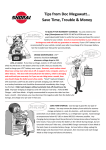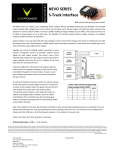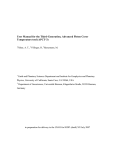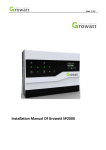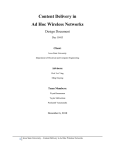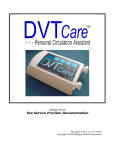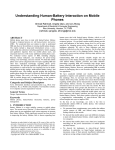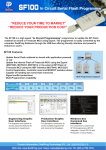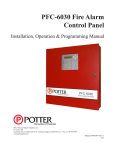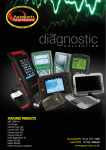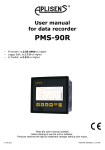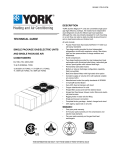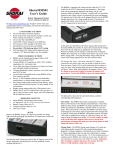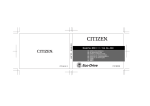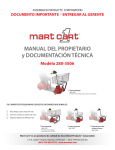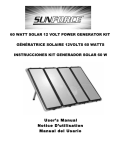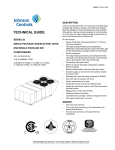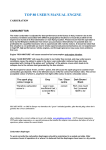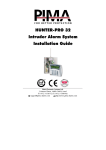Download Shorai FAQ - Vancouver Battery
Transcript
Freq quently y Asked Quesstions Q. Hoow do I maintai m in my Sh horai LF FX Batttery? b shou uld be rechaarged wheneever voltagee drops to 13.1 volts, orr sooner. Iff you LFX™ batteries have a viintage, custo om, or off-road vehicle which w has NO O draw on thhe battery whhen key is OFF, O then you should only y need to chaarge your LF FX™ batteryy once a yearr. However, most modeern street bik kes have a draw d even when w key is off, to supp port clock, computer, c a alarms, or otther devices. This draw will eventually drain th he battery, which is daamaging and d could void d your warrranty. So if i you are noot riding tw wice a month h, then you should s charrge the batteery every few w weeks. “S Smart” lead-aacid chargerrs with autom matic cutoff may m be usedd for periodicc charging, but will NO OT work as a tender/maiintainer and should be disconnected immediatelyy after charrge has finisshed. Older lead chargeers without automatic shut-off shoould never be b used. Im mproper charg ging is dangerous and will w void yourr warranty. A Shorai BM MS Charger with Storre Mode - is highly recom mmended foor anyone whho rides lesss than twice a month. Alternatiively, you may m disconnect the negatiive cable froom the batterry for storagee, and chargge once per year in that case. Q. What W is th he best way w to facilitate f e long teerm storrage? A. Cool storage s is go ood for any type t of battery. You maay remove thhe battery froom vehicle foor summer storage s and place in a coool, dry locaation – with terminals t tapped to avoid short circuitt (ideal is about 34F F/1C, so a reefrigerator iss great). Avoid storage at a temperatuures below 0F F/-18C or abbove 90F/32C whenever possible. p Anny charging during d storagge should bee performed at temperatuures above freeezing, for best results. If I you want to t keep the battery b in thee vehicle durring storage,, but are uncerrtain when you’ll y ride neext, a Shorai BMS Chargger connecteed in Store Mode M is the best b choice too maintain baattery chargee. An hour before b ridingg, unplug thee BMS chargger and disconneect from walll power, thenn reconnect and start Chharge Mode to t fully chargge and balannce the batterry. Q. Hoow does the LFX X "PBeq q AHr" capacitty ratingg compaare to lead d-acid Ahr A ratiings? A. First, we need to understand u that the prim mary job of a starter batteery is to flow w a large currrent (amperagge) for a short time, in orrder to start a vehicle. Inn order to do that efficienntly, the batttery must havve low intern nal resistancee. Holding all other conssiderations equal, e the larrger the batteery is in capaciity the lowerr the resistannce, and the better b able itt is to crank a vehicle unnder high loaads. Lead-acid makers haave thereforee used AHr(ccapacity) ratiings as shortthand to indiicate crankinng ability, raather than a real usable capacity. c The lead-acid capacity c ratinng itself is based b on a completee discharge at a a low dischharge rate. Under U actuall cranking coonditions theey will deliveer consideraably less thaan spec capaccity. And because lead-aacid batteriess begin sulfaating when only o a small perrcentage of the t capacity has been useed, and theirr internal ressistance risess as they are dischargeed, the actuaal capacity which w can be USED mayy be as little as a 20% of thhe mfg. ratinng. Dischargge in excess will w not onlyy damage thee lead-acid battery, b it maay not allow proper startting as voltagge sags. Shorai LF FX are based d on a comppletely differrent chemistrry. Not only do they havve less than 1/3 1 the internnal resistance per capacity than do leead-acid, theey are also thhe ultimate "deep-cycle" battery. The T internal "completelyy discharged" capacity of a Shorai LF FX is 1/3 thee rated "PBeeq" capacity. For examplle, the LFX118 12V series have 6Ah cells internaally. But the cells are cappable of 80% discharge d witthout damagge and while retaining more m crankingg ability. As such, the USABLE E capacity(or "reserve caapacity") of an LFX18 12V battery is i on or veryy near par wiith 18AHr-raated lead aciid batteries, while providding superioor cranking performance p and a vast reductionn in weight. The Shorai PBeq P AHr (llead-acid equuivalent) ratting system therefore t allows users to compare c a veery differentt technologyy from lead-aacid, but on a close applees-to-apples basis wheen making a choice. Q. Ad ddressin ng Waterr and Corrosion n? A. WAT TER/CORRO OSION: Avvoid high preessure powerr washing arround the baattery case, or o constant exposure to water. If thhe battery maay be occasioonally subm merged, we hiighly suggesst applicatioon of sealantt to fill the horizontal h seam betweeen top and bottom b of th he battery case, and that the 5-pin port be fully packed with dielectric grease. (dielectric grease is a good idea in any case to insure no pin corrosion). Also, heavy grease should be liberally applied to terminals for wet environments Q. How does the LFX "CCA" cold-cranking rating compare to lead-acid Ahr ratings? A. CCA ratings another way that lead-acid makers have tried to convey starting power. Unfortunately, their typical spec is based on a "half-nominal-voltage" delivery. That is, at their CCA spec, you can expect 7.2V delivered, at best; and 7.2V isn't useful, as you won't start a vehicle with it... In any case, CCA ratings aren't about actually drawing that much current from a battery. The typical vehicle which uses a 200A CCA-rated battery, for example, will only draw 45A~80A from the battery. What the CCA rating really intends to convey is how much voltage will be delivered. Higher CCA rated batteries will deliver more voltage at the same actual cranking current. Our LFX are CCA rated to deliver 9V for a 5-second crank at the CCA rated current. (in fact, our average voltage delivered will be even higher during a 30-second crank. But our CCA ratings are intended to indicate not only a measure of voltage at true cranking currents, but also proper usage, which lead-acid do not) At actual cranking currents - which are always well below CCA, LFX deliver up to two volts more than an equivalent-CCA-rated lead acid battery. Current alone won't start anything. It is the current multiplied by voltage that does the work (watts). In reality, this means that you can multiply the LFX CCA rating by 1.5x to compare to a Lead Acid battery CCA. For example, our 270A CCA LFX18 series provides about the same cranking voltage as a 405A-CCA-rated lead acid battery (from a quality lead-acid maker; some CCA specs we've tested on the cheapest lead acid seemed to be plucked from thin air). Q. Can I use Lead-Acid battery chargers or charger/tenders? A. Yes. HOWEVER, you may NOT use a charger/tender if it has an automatic "desulfation mode", which cannot be turned off. If you are storing your vehicle and want to check the remaining capacity, or you're a racer with a constant-loss system, you'll want to know how resting voltage (i.e. with no load or load under 200mA) maps to remaining capacity. LFX batteries should be maintained such that 20% capacity remains at minimum, as best practice. Use a good-quality voltmeter to check remaining capacity, and consider recharge whenever the battery capacity falls to about 50% remaining. Of course, if you get the Shorai dedicated BMS01 charger, you can just hit the "Store Mode" button and leave it to do the work for you. Q. What about Safety Precautions? Starter batteries of any type contain a large amount of energy. During a short circuit, ALL that energy is released in a matter of seconds, creating an extremely hot arc welder, possibly causing fire or explosion. You MUST be very careful at all times to avoid short circuit of the positive and negative terminals. Do NOT wear jewelry on wrist or neck while handling batteries. INSURE that when installed the positive and negative terminals are properly covered and insulated from the vehicle. Do NOT use carbon fiber battery hold down units, as carbon is an electrical conductor. Be CAREFUL! Q. Cold Weather Performance Expectations? A. Downn to about 20 0 degrees Fahhrenheit (-7C C) most userrs find that thhey can startt normally on o first crannk. If your heeadlight com mes on at keyy-ON, it is goood for the batteries b to flow f some current before b crankiing in cold weather. w Thee suggested headlight-on h time beforee cranking depends on the tempeerature. If sttarting at 40F F/5C, 30 secconds will heelp wake thee battery andd increase cranking perrformance. If I at 0F/-17C C, leave the lights l on for 4~5 minutes before cranking. The result will w be a bettter first crannk, and longeer battery liffe. If the enggine fails to start on first crank, c that firrst crank hass warmed thee battery, annd the secondd attempt wiill be much stronger. Other accesssories that can c be turnedd on before cranking c cann also be useed for this purpose, such as heatted gear, raddio, etc... Inssuring that thhe battery is fully chargeed after storaage also imprroves first-sttart performaance in cold weather. Q. Hoow can I verify Warran W nty Coveerage? You only need to visit http://shoraipower.com PRIOR TO INSTALLATION and use our year/make/model finder to verify that you have purchased the correct battery for your vehicle. Use of an incorrect battery in your vehicle can be dangerous and will void any guarantee or warranty. If your LFX™ battery is not recommended for your vehicle, contact your seller to exchange it for the proper battery. See the included User Manual for warranty details.








